Conflict Resolution and Management in Hospitality Industry Report
VerifiedAdded on 2023/05/30
|9
|1770
|77
Report
AI Summary
This report addresses conflict resolution in the context of the hospitality industry, examining various scenarios and applying different conflict management techniques. The report begins with an analysis of a customer complaint scenario, detailing the use of problem-solving, compromising, and smoothing techniques to address the issue and prevent negative consequences. It then explores a scenario involving communication barriers with a foreign customer, suggesting the use of nonverbal cues and training for staff to overcome these challenges. The report further delves into a workplace conflict scenario, highlighting the importance of equal opportunities and effective management in resolving disputes and maintaining productivity. Finally, it addresses a scenario involving an intoxicated customer, emphasizing the importance of staff safety and proper documentation. The report concludes by outlining organizational procedures for conflict management, including regulatory requirements and the significance of training and employee participation in creating a peaceful work environment.
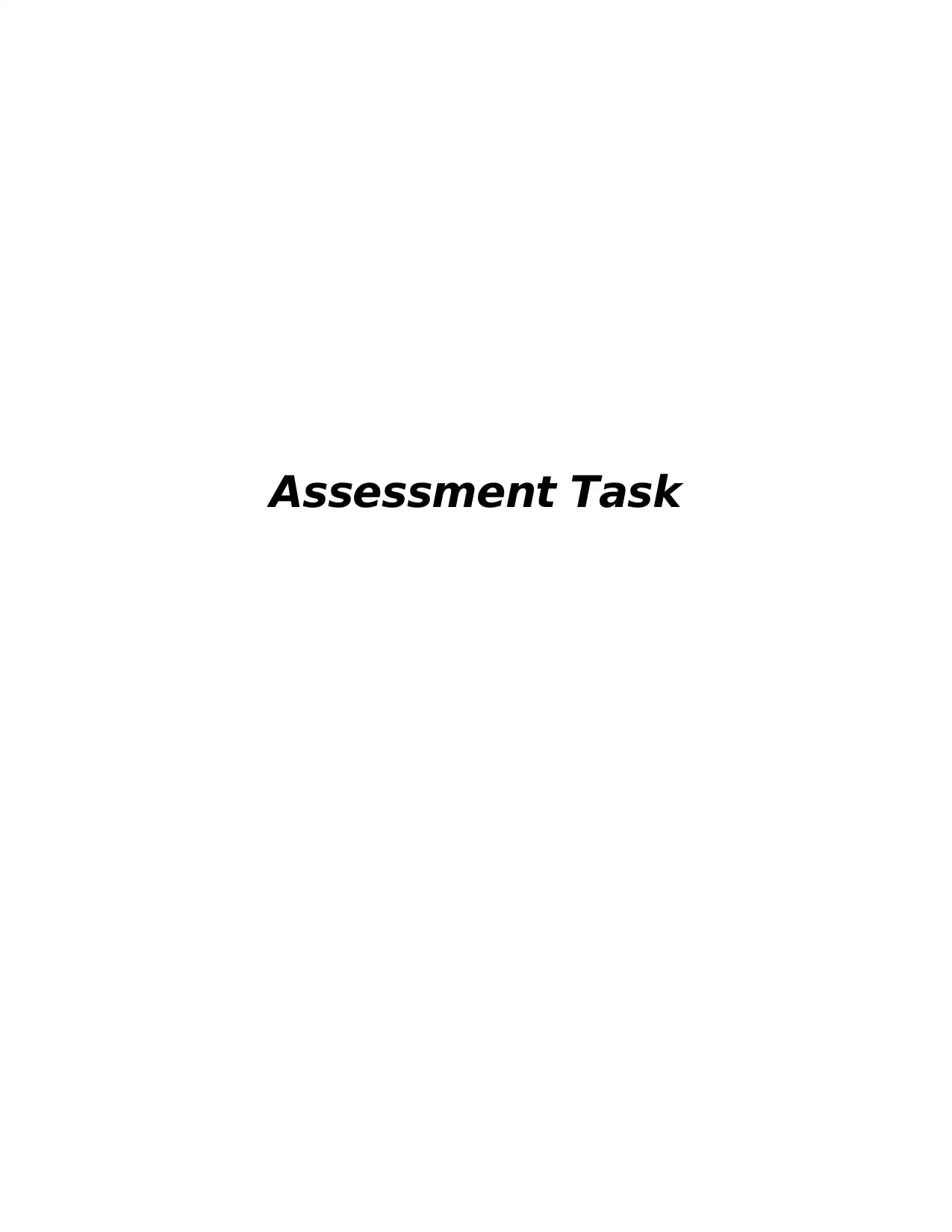
Assessment Task
Paraphrase This Document
Need a fresh take? Get an instant paraphrase of this document with our AI Paraphraser
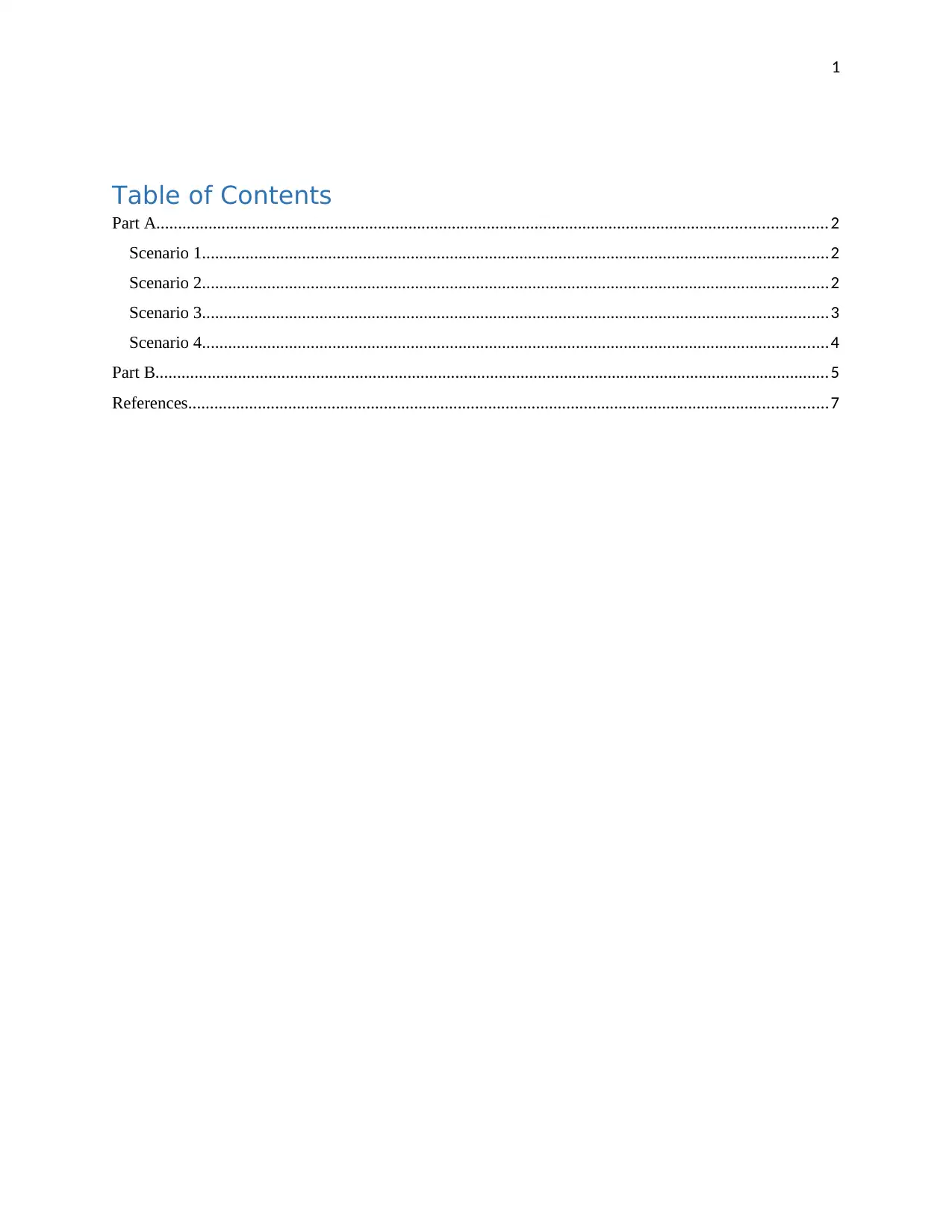
1
Table of Contents
Part A..........................................................................................................................................................2
Scenario 1................................................................................................................................................2
Scenario 2................................................................................................................................................2
Scenario 3................................................................................................................................................3
Scenario 4................................................................................................................................................4
Part B...........................................................................................................................................................5
References...................................................................................................................................................7
Table of Contents
Part A..........................................................................................................................................................2
Scenario 1................................................................................................................................................2
Scenario 2................................................................................................................................................2
Scenario 3................................................................................................................................................3
Scenario 4................................................................................................................................................4
Part B...........................................................................................................................................................5
References...................................................................................................................................................7
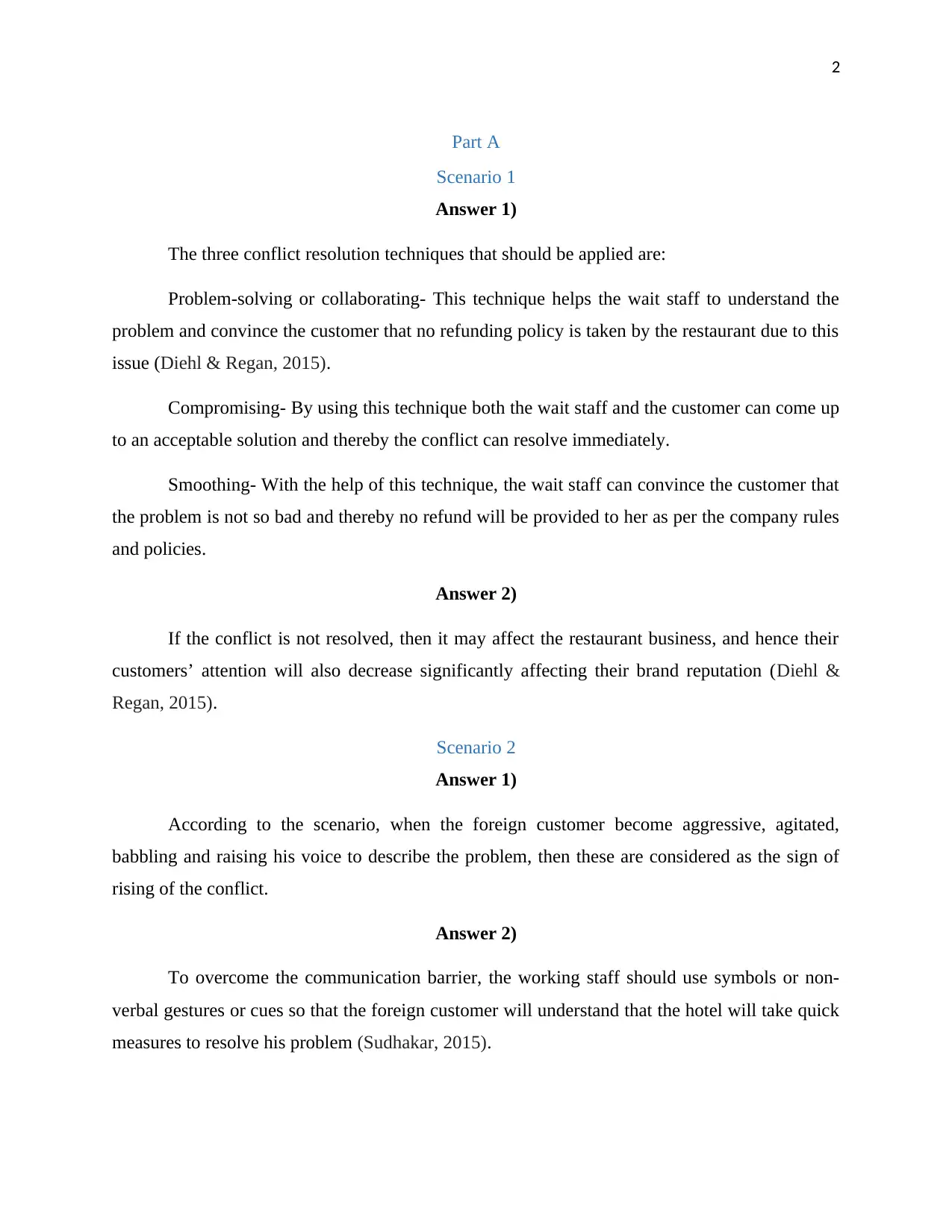
2
Part A
Scenario 1
Answer 1)
The three conflict resolution techniques that should be applied are:
Problem-solving or collaborating- This technique helps the wait staff to understand the
problem and convince the customer that no refunding policy is taken by the restaurant due to this
issue (Diehl & Regan, 2015).
Compromising- By using this technique both the wait staff and the customer can come up
to an acceptable solution and thereby the conflict can resolve immediately.
Smoothing- With the help of this technique, the wait staff can convince the customer that
the problem is not so bad and thereby no refund will be provided to her as per the company rules
and policies.
Answer 2)
If the conflict is not resolved, then it may affect the restaurant business, and hence their
customers’ attention will also decrease significantly affecting their brand reputation (Diehl &
Regan, 2015).
Scenario 2
Answer 1)
According to the scenario, when the foreign customer become aggressive, agitated,
babbling and raising his voice to describe the problem, then these are considered as the sign of
rising of the conflict.
Answer 2)
To overcome the communication barrier, the working staff should use symbols or non-
verbal gestures or cues so that the foreign customer will understand that the hotel will take quick
measures to resolve his problem (Sudhakar, 2015).
Part A
Scenario 1
Answer 1)
The three conflict resolution techniques that should be applied are:
Problem-solving or collaborating- This technique helps the wait staff to understand the
problem and convince the customer that no refunding policy is taken by the restaurant due to this
issue (Diehl & Regan, 2015).
Compromising- By using this technique both the wait staff and the customer can come up
to an acceptable solution and thereby the conflict can resolve immediately.
Smoothing- With the help of this technique, the wait staff can convince the customer that
the problem is not so bad and thereby no refund will be provided to her as per the company rules
and policies.
Answer 2)
If the conflict is not resolved, then it may affect the restaurant business, and hence their
customers’ attention will also decrease significantly affecting their brand reputation (Diehl &
Regan, 2015).
Scenario 2
Answer 1)
According to the scenario, when the foreign customer become aggressive, agitated,
babbling and raising his voice to describe the problem, then these are considered as the sign of
rising of the conflict.
Answer 2)
To overcome the communication barrier, the working staff should use symbols or non-
verbal gestures or cues so that the foreign customer will understand that the hotel will take quick
measures to resolve his problem (Sudhakar, 2015).
⊘ This is a preview!⊘
Do you want full access?
Subscribe today to unlock all pages.

Trusted by 1+ million students worldwide
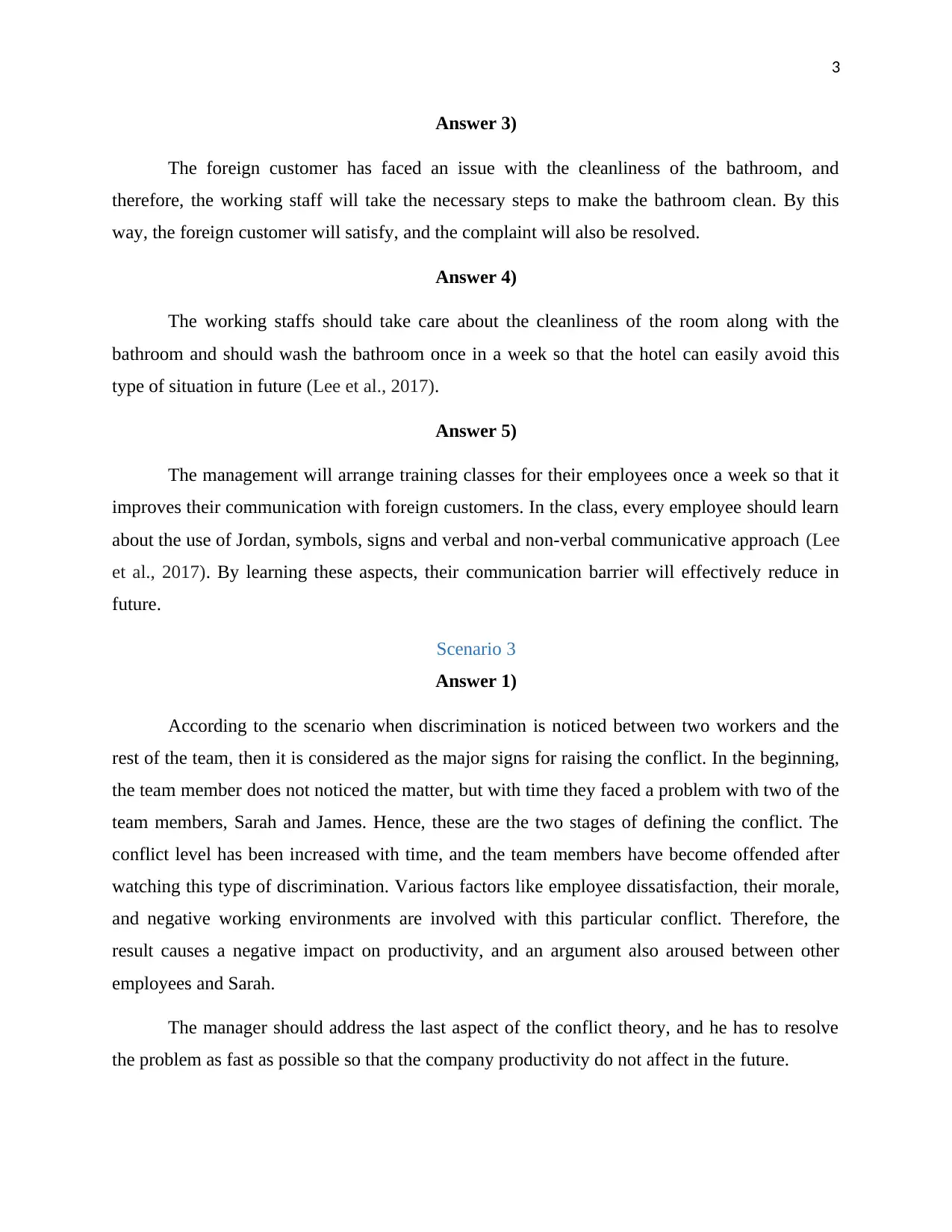
3
Answer 3)
The foreign customer has faced an issue with the cleanliness of the bathroom, and
therefore, the working staff will take the necessary steps to make the bathroom clean. By this
way, the foreign customer will satisfy, and the complaint will also be resolved.
Answer 4)
The working staffs should take care about the cleanliness of the room along with the
bathroom and should wash the bathroom once in a week so that the hotel can easily avoid this
type of situation in future (Lee et al., 2017).
Answer 5)
The management will arrange training classes for their employees once a week so that it
improves their communication with foreign customers. In the class, every employee should learn
about the use of Jordan, symbols, signs and verbal and non-verbal communicative approach (Lee
et al., 2017). By learning these aspects, their communication barrier will effectively reduce in
future.
Scenario 3
Answer 1)
According to the scenario when discrimination is noticed between two workers and the
rest of the team, then it is considered as the major signs for raising the conflict. In the beginning,
the team member does not noticed the matter, but with time they faced a problem with two of the
team members, Sarah and James. Hence, these are the two stages of defining the conflict. The
conflict level has been increased with time, and the team members have become offended after
watching this type of discrimination. Various factors like employee dissatisfaction, their morale,
and negative working environments are involved with this particular conflict. Therefore, the
result causes a negative impact on productivity, and an argument also aroused between other
employees and Sarah.
The manager should address the last aspect of the conflict theory, and he has to resolve
the problem as fast as possible so that the company productivity do not affect in the future.
Answer 3)
The foreign customer has faced an issue with the cleanliness of the bathroom, and
therefore, the working staff will take the necessary steps to make the bathroom clean. By this
way, the foreign customer will satisfy, and the complaint will also be resolved.
Answer 4)
The working staffs should take care about the cleanliness of the room along with the
bathroom and should wash the bathroom once in a week so that the hotel can easily avoid this
type of situation in future (Lee et al., 2017).
Answer 5)
The management will arrange training classes for their employees once a week so that it
improves their communication with foreign customers. In the class, every employee should learn
about the use of Jordan, symbols, signs and verbal and non-verbal communicative approach (Lee
et al., 2017). By learning these aspects, their communication barrier will effectively reduce in
future.
Scenario 3
Answer 1)
According to the scenario when discrimination is noticed between two workers and the
rest of the team, then it is considered as the major signs for raising the conflict. In the beginning,
the team member does not noticed the matter, but with time they faced a problem with two of the
team members, Sarah and James. Hence, these are the two stages of defining the conflict. The
conflict level has been increased with time, and the team members have become offended after
watching this type of discrimination. Various factors like employee dissatisfaction, their morale,
and negative working environments are involved with this particular conflict. Therefore, the
result causes a negative impact on productivity, and an argument also aroused between other
employees and Sarah.
The manager should address the last aspect of the conflict theory, and he has to resolve
the problem as fast as possible so that the company productivity do not affect in the future.
Paraphrase This Document
Need a fresh take? Get an instant paraphrase of this document with our AI Paraphraser
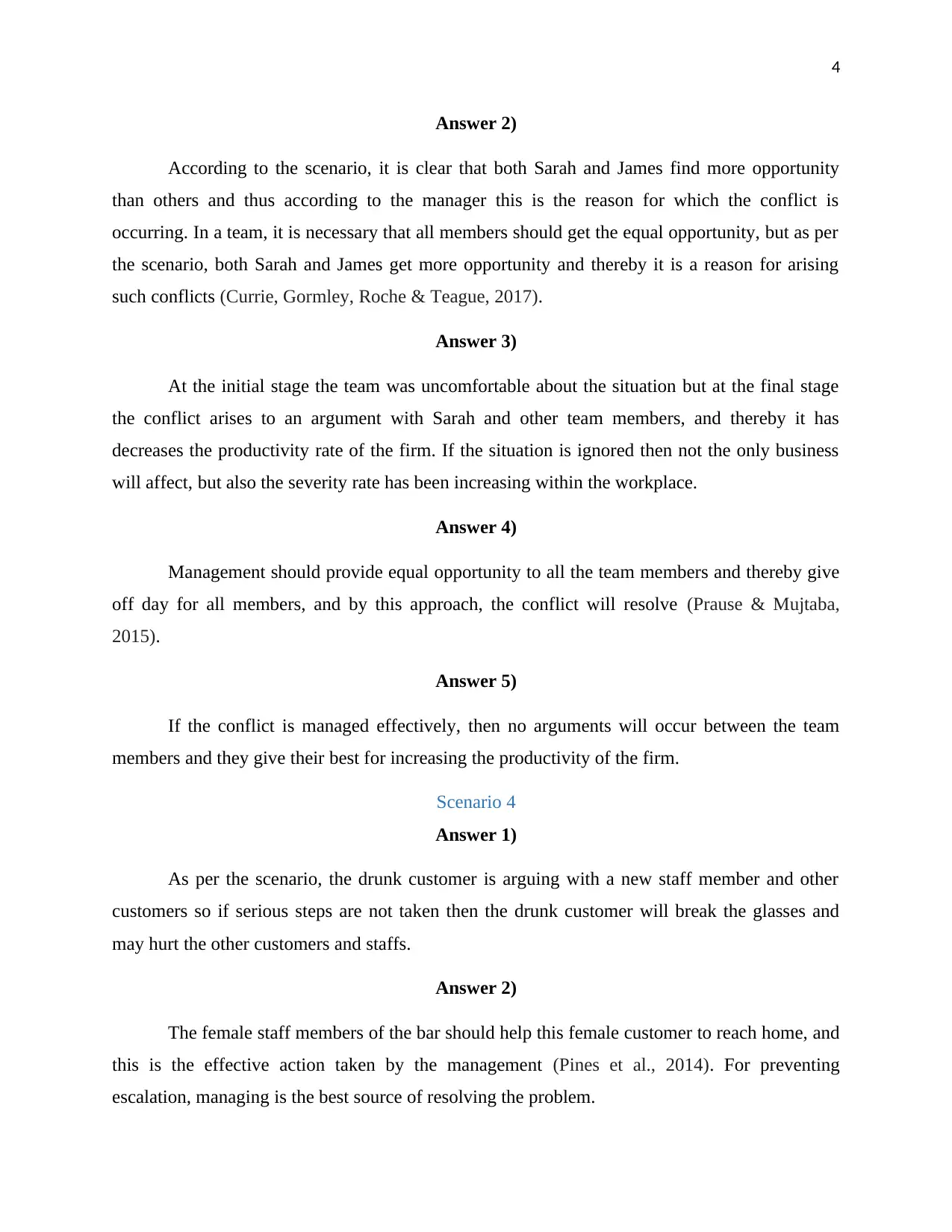
4
Answer 2)
According to the scenario, it is clear that both Sarah and James find more opportunity
than others and thus according to the manager this is the reason for which the conflict is
occurring. In a team, it is necessary that all members should get the equal opportunity, but as per
the scenario, both Sarah and James get more opportunity and thereby it is a reason for arising
such conflicts (Currie, Gormley, Roche & Teague, 2017).
Answer 3)
At the initial stage the team was uncomfortable about the situation but at the final stage
the conflict arises to an argument with Sarah and other team members, and thereby it has
decreases the productivity rate of the firm. If the situation is ignored then not the only business
will affect, but also the severity rate has been increasing within the workplace.
Answer 4)
Management should provide equal opportunity to all the team members and thereby give
off day for all members, and by this approach, the conflict will resolve (Prause & Mujtaba,
2015).
Answer 5)
If the conflict is managed effectively, then no arguments will occur between the team
members and they give their best for increasing the productivity of the firm.
Scenario 4
Answer 1)
As per the scenario, the drunk customer is arguing with a new staff member and other
customers so if serious steps are not taken then the drunk customer will break the glasses and
may hurt the other customers and staffs.
Answer 2)
The female staff members of the bar should help this female customer to reach home, and
this is the effective action taken by the management (Pines et al., 2014). For preventing
escalation, managing is the best source of resolving the problem.
Answer 2)
According to the scenario, it is clear that both Sarah and James find more opportunity
than others and thus according to the manager this is the reason for which the conflict is
occurring. In a team, it is necessary that all members should get the equal opportunity, but as per
the scenario, both Sarah and James get more opportunity and thereby it is a reason for arising
such conflicts (Currie, Gormley, Roche & Teague, 2017).
Answer 3)
At the initial stage the team was uncomfortable about the situation but at the final stage
the conflict arises to an argument with Sarah and other team members, and thereby it has
decreases the productivity rate of the firm. If the situation is ignored then not the only business
will affect, but also the severity rate has been increasing within the workplace.
Answer 4)
Management should provide equal opportunity to all the team members and thereby give
off day for all members, and by this approach, the conflict will resolve (Prause & Mujtaba,
2015).
Answer 5)
If the conflict is managed effectively, then no arguments will occur between the team
members and they give their best for increasing the productivity of the firm.
Scenario 4
Answer 1)
As per the scenario, the drunk customer is arguing with a new staff member and other
customers so if serious steps are not taken then the drunk customer will break the glasses and
may hurt the other customers and staffs.
Answer 2)
The female staff members of the bar should help this female customer to reach home, and
this is the effective action taken by the management (Pines et al., 2014). For preventing
escalation, managing is the best source of resolving the problem.
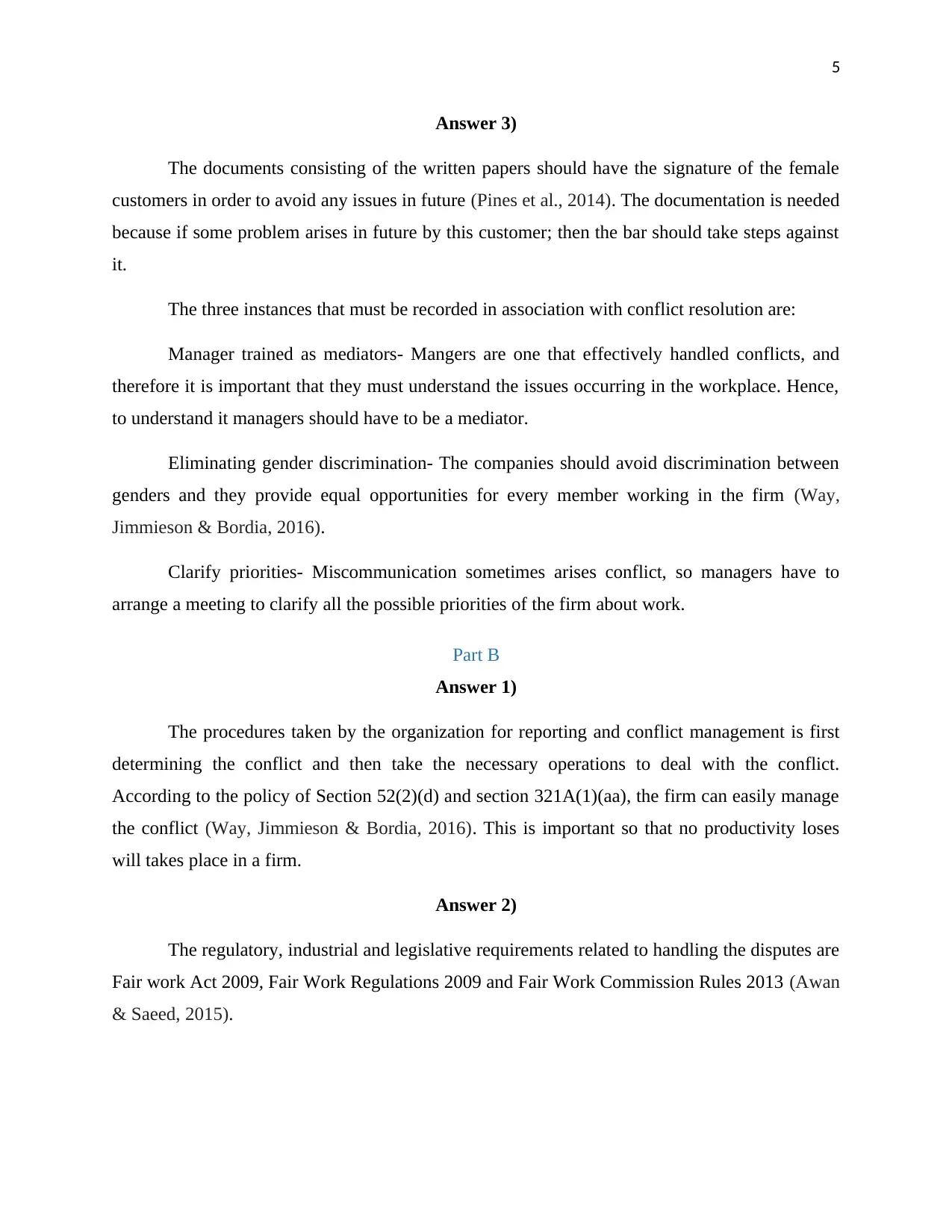
5
Answer 3)
The documents consisting of the written papers should have the signature of the female
customers in order to avoid any issues in future (Pines et al., 2014). The documentation is needed
because if some problem arises in future by this customer; then the bar should take steps against
it.
The three instances that must be recorded in association with conflict resolution are:
Manager trained as mediators- Mangers are one that effectively handled conflicts, and
therefore it is important that they must understand the issues occurring in the workplace. Hence,
to understand it managers should have to be a mediator.
Eliminating gender discrimination- The companies should avoid discrimination between
genders and they provide equal opportunities for every member working in the firm (Way,
Jimmieson & Bordia, 2016).
Clarify priorities- Miscommunication sometimes arises conflict, so managers have to
arrange a meeting to clarify all the possible priorities of the firm about work.
Part B
Answer 1)
The procedures taken by the organization for reporting and conflict management is first
determining the conflict and then take the necessary operations to deal with the conflict.
According to the policy of Section 52(2)(d) and section 321A(1)(aa), the firm can easily manage
the conflict (Way, Jimmieson & Bordia, 2016). This is important so that no productivity loses
will takes place in a firm.
Answer 2)
The regulatory, industrial and legislative requirements related to handling the disputes are
Fair work Act 2009, Fair Work Regulations 2009 and Fair Work Commission Rules 2013 (Awan
& Saeed, 2015).
Answer 3)
The documents consisting of the written papers should have the signature of the female
customers in order to avoid any issues in future (Pines et al., 2014). The documentation is needed
because if some problem arises in future by this customer; then the bar should take steps against
it.
The three instances that must be recorded in association with conflict resolution are:
Manager trained as mediators- Mangers are one that effectively handled conflicts, and
therefore it is important that they must understand the issues occurring in the workplace. Hence,
to understand it managers should have to be a mediator.
Eliminating gender discrimination- The companies should avoid discrimination between
genders and they provide equal opportunities for every member working in the firm (Way,
Jimmieson & Bordia, 2016).
Clarify priorities- Miscommunication sometimes arises conflict, so managers have to
arrange a meeting to clarify all the possible priorities of the firm about work.
Part B
Answer 1)
The procedures taken by the organization for reporting and conflict management is first
determining the conflict and then take the necessary operations to deal with the conflict.
According to the policy of Section 52(2)(d) and section 321A(1)(aa), the firm can easily manage
the conflict (Way, Jimmieson & Bordia, 2016). This is important so that no productivity loses
will takes place in a firm.
Answer 2)
The regulatory, industrial and legislative requirements related to handling the disputes are
Fair work Act 2009, Fair Work Regulations 2009 and Fair Work Commission Rules 2013 (Awan
& Saeed, 2015).
⊘ This is a preview!⊘
Do you want full access?
Subscribe today to unlock all pages.

Trusted by 1+ million students worldwide
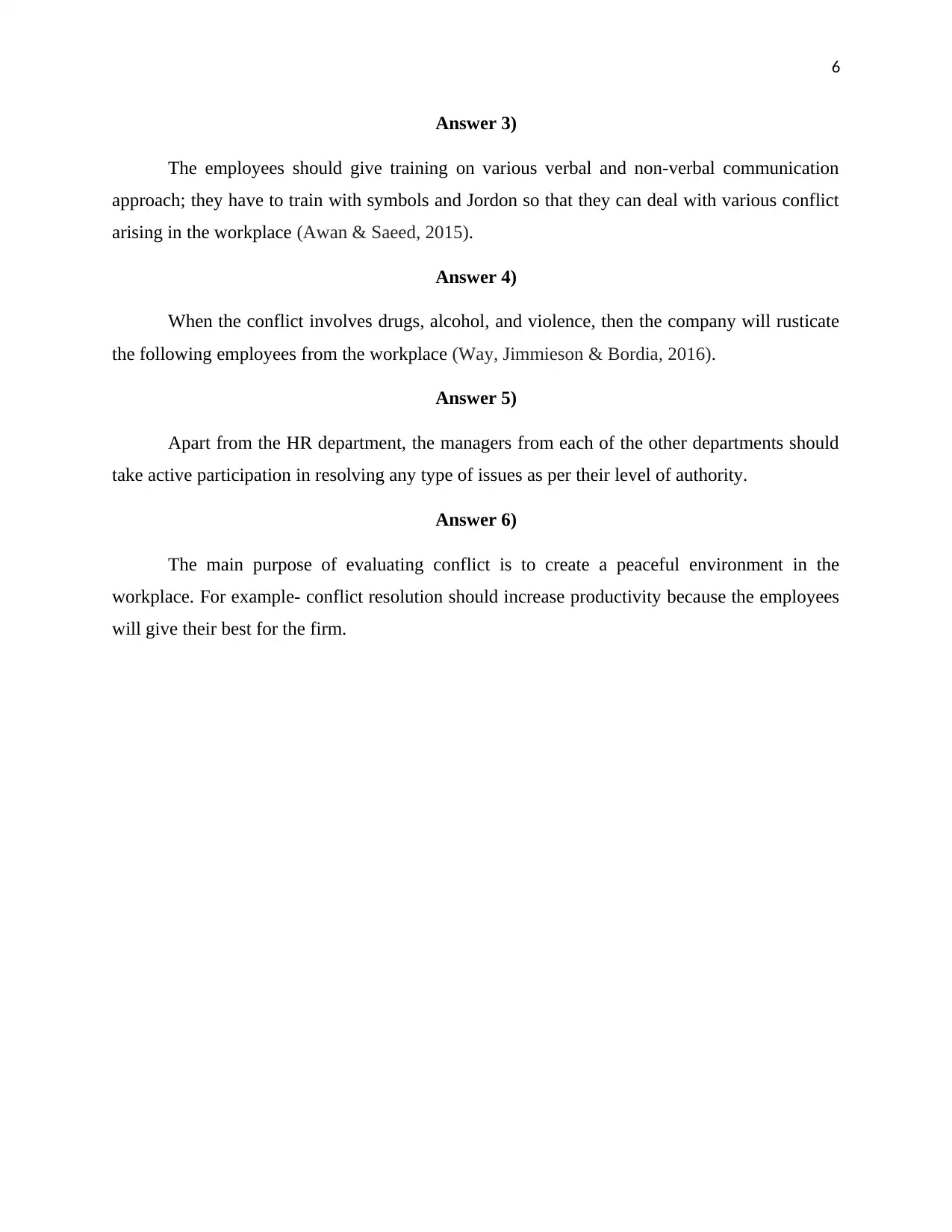
6
Answer 3)
The employees should give training on various verbal and non-verbal communication
approach; they have to train with symbols and Jordon so that they can deal with various conflict
arising in the workplace (Awan & Saeed, 2015).
Answer 4)
When the conflict involves drugs, alcohol, and violence, then the company will rusticate
the following employees from the workplace (Way, Jimmieson & Bordia, 2016).
Answer 5)
Apart from the HR department, the managers from each of the other departments should
take active participation in resolving any type of issues as per their level of authority.
Answer 6)
The main purpose of evaluating conflict is to create a peaceful environment in the
workplace. For example- conflict resolution should increase productivity because the employees
will give their best for the firm.
Answer 3)
The employees should give training on various verbal and non-verbal communication
approach; they have to train with symbols and Jordon so that they can deal with various conflict
arising in the workplace (Awan & Saeed, 2015).
Answer 4)
When the conflict involves drugs, alcohol, and violence, then the company will rusticate
the following employees from the workplace (Way, Jimmieson & Bordia, 2016).
Answer 5)
Apart from the HR department, the managers from each of the other departments should
take active participation in resolving any type of issues as per their level of authority.
Answer 6)
The main purpose of evaluating conflict is to create a peaceful environment in the
workplace. For example- conflict resolution should increase productivity because the employees
will give their best for the firm.
Paraphrase This Document
Need a fresh take? Get an instant paraphrase of this document with our AI Paraphraser
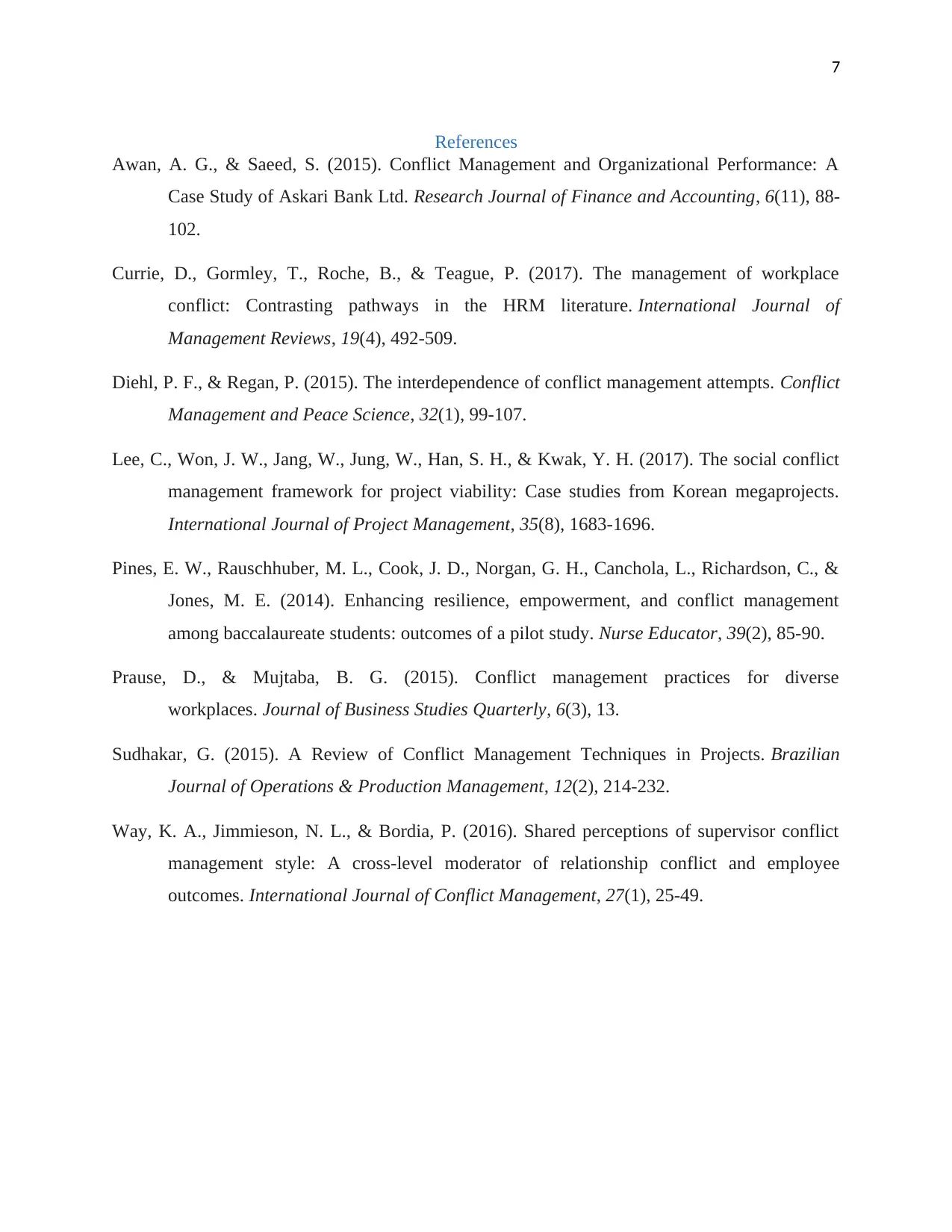
7
References
Awan, A. G., & Saeed, S. (2015). Conflict Management and Organizational Performance: A
Case Study of Askari Bank Ltd. Research Journal of Finance and Accounting, 6(11), 88-
102.
Currie, D., Gormley, T., Roche, B., & Teague, P. (2017). The management of workplace
conflict: Contrasting pathways in the HRM literature. International Journal of
Management Reviews, 19(4), 492-509.
Diehl, P. F., & Regan, P. (2015). The interdependence of conflict management attempts. Conflict
Management and Peace Science, 32(1), 99-107.
Lee, C., Won, J. W., Jang, W., Jung, W., Han, S. H., & Kwak, Y. H. (2017). The social conflict
management framework for project viability: Case studies from Korean megaprojects.
International Journal of Project Management, 35(8), 1683-1696.
Pines, E. W., Rauschhuber, M. L., Cook, J. D., Norgan, G. H., Canchola, L., Richardson, C., &
Jones, M. E. (2014). Enhancing resilience, empowerment, and conflict management
among baccalaureate students: outcomes of a pilot study. Nurse Educator, 39(2), 85-90.
Prause, D., & Mujtaba, B. G. (2015). Conflict management practices for diverse
workplaces. Journal of Business Studies Quarterly, 6(3), 13.
Sudhakar, G. (2015). A Review of Conflict Management Techniques in Projects. Brazilian
Journal of Operations & Production Management, 12(2), 214-232.
Way, K. A., Jimmieson, N. L., & Bordia, P. (2016). Shared perceptions of supervisor conflict
management style: A cross-level moderator of relationship conflict and employee
outcomes. International Journal of Conflict Management, 27(1), 25-49.
References
Awan, A. G., & Saeed, S. (2015). Conflict Management and Organizational Performance: A
Case Study of Askari Bank Ltd. Research Journal of Finance and Accounting, 6(11), 88-
102.
Currie, D., Gormley, T., Roche, B., & Teague, P. (2017). The management of workplace
conflict: Contrasting pathways in the HRM literature. International Journal of
Management Reviews, 19(4), 492-509.
Diehl, P. F., & Regan, P. (2015). The interdependence of conflict management attempts. Conflict
Management and Peace Science, 32(1), 99-107.
Lee, C., Won, J. W., Jang, W., Jung, W., Han, S. H., & Kwak, Y. H. (2017). The social conflict
management framework for project viability: Case studies from Korean megaprojects.
International Journal of Project Management, 35(8), 1683-1696.
Pines, E. W., Rauschhuber, M. L., Cook, J. D., Norgan, G. H., Canchola, L., Richardson, C., &
Jones, M. E. (2014). Enhancing resilience, empowerment, and conflict management
among baccalaureate students: outcomes of a pilot study. Nurse Educator, 39(2), 85-90.
Prause, D., & Mujtaba, B. G. (2015). Conflict management practices for diverse
workplaces. Journal of Business Studies Quarterly, 6(3), 13.
Sudhakar, G. (2015). A Review of Conflict Management Techniques in Projects. Brazilian
Journal of Operations & Production Management, 12(2), 214-232.
Way, K. A., Jimmieson, N. L., & Bordia, P. (2016). Shared perceptions of supervisor conflict
management style: A cross-level moderator of relationship conflict and employee
outcomes. International Journal of Conflict Management, 27(1), 25-49.

8
⊘ This is a preview!⊘
Do you want full access?
Subscribe today to unlock all pages.

Trusted by 1+ million students worldwide
1 out of 9
Your All-in-One AI-Powered Toolkit for Academic Success.
+13062052269
info@desklib.com
Available 24*7 on WhatsApp / Email
![[object Object]](/_next/static/media/star-bottom.7253800d.svg)
Unlock your academic potential
Copyright © 2020–2025 A2Z Services. All Rights Reserved. Developed and managed by ZUCOL.

